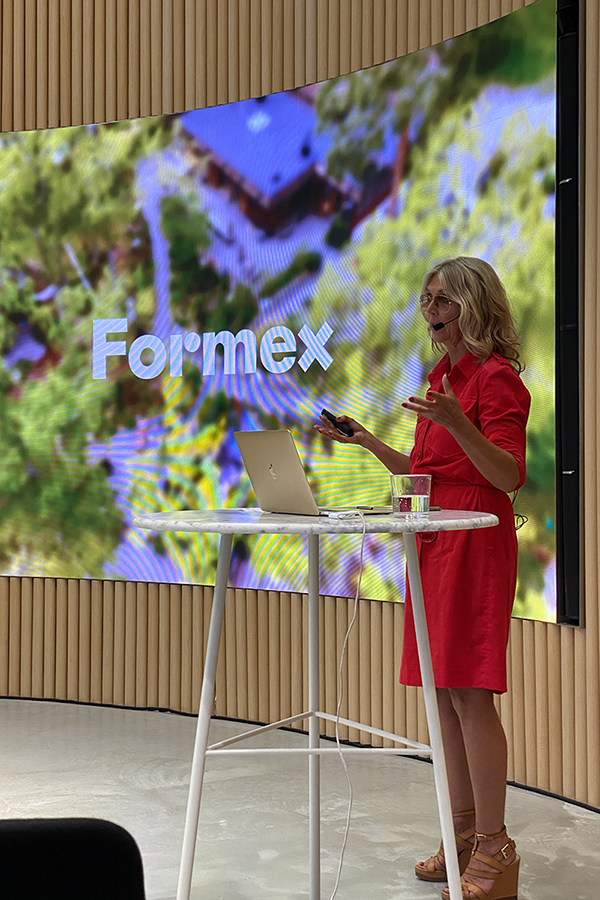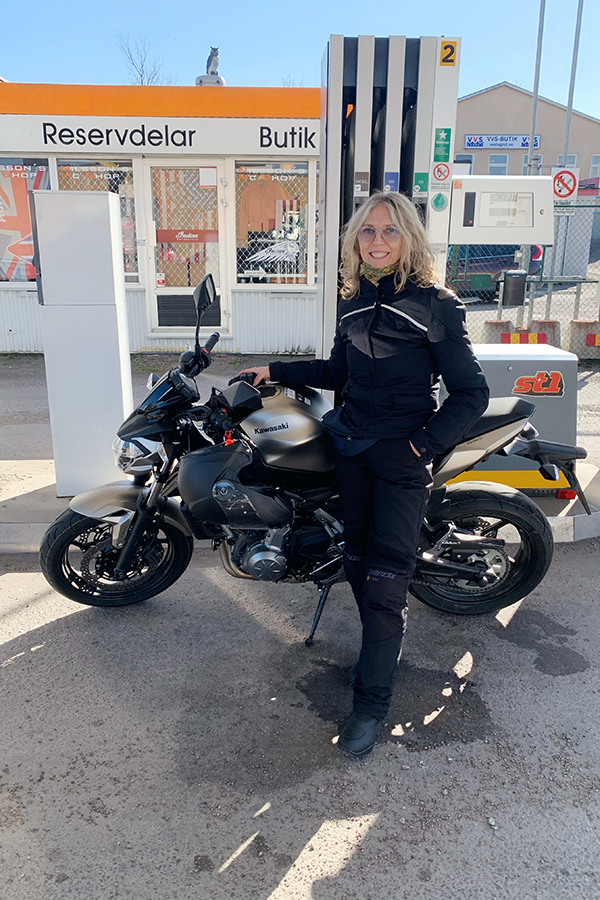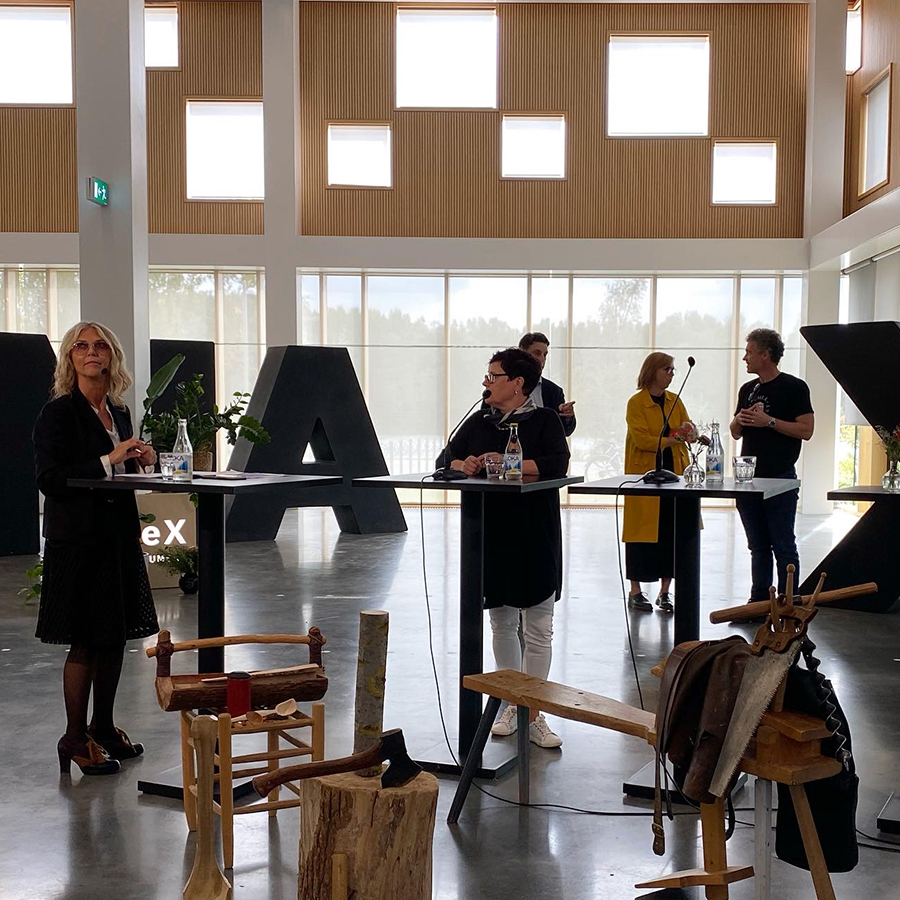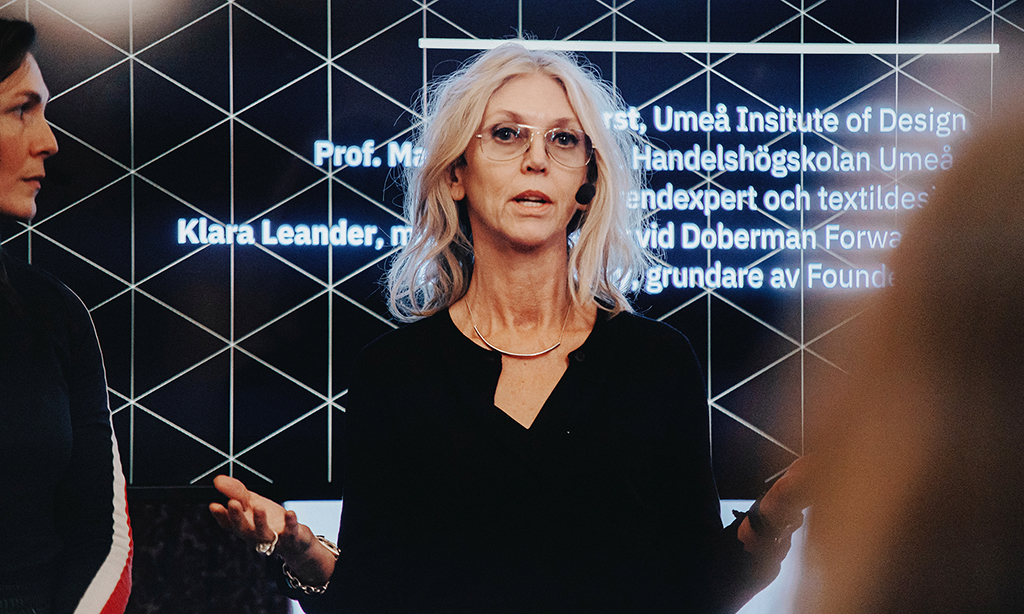Akenberg meets
Lotta Ahlvar
There is a new fashion landscape. Say ‘Goodbye’ to trends, fast fashion and it-bags, and ´’Hello’ to a whole new approach on craftmanship, vintage, and how to create with passion, quality and sustainability in focus.
In this blunt and inane world filled with commerce, sustainable textiles, crafts and unique design couldn’t be more well timed. To Lotta Ahlvar, this has been the focus since early age. With her in-depth knowledge of design and broad network within the field of textiles, she has been instrumental within the Scandinavian fashion and interior design industries for the past 30 years.
Trained fashion designer, she started her career at H&M women’s department in 1994, designing everything from underwear and maternity clothing to sportswear and trendy fashion garments. Since then she has had numerous positions including twelve years as CEO for the Swedish Fashion council, board member of the Nordic Cashion Association and CEO at Handarbetets Vänner, one of the oldest and most distinguished handicraft and textile institutions in Sweden, just to name a few.
As a trend forecaster, Lotta anticipates a bright future for preserving cultural heritage, textile handicraft and artistic innovation. For sure, the future is challenging, she emphasizes, especially for the fashion industry, but also filled with opportunities,
– It has clearly been a difficult time for the fashion industry and retail in general. With so many of us working from home, you don’t really need a new wardrobe, and many have realized that they already have too many garments. Many stores have had to close down which is very sad, as well as we see many independent designers struggling to survive. However, during the pandemic we’ve also been able to see what is actually working. Take the second-hand market and the sales of vintage that have increased a lot, and that is one of the most important changes within fashion today. What will be the effect is that we will be more careful with what we choose in the future. Locally produced and bespoke garments and objects will be more important to us. I think that every brand that can tell a story that connects to people will be more in demand. Young people today not finding exactly what they want, will rediscover the art of tailoring and customize what they want. So, brands working with on-demand and bespoke will be much more in focus.

Sustainability is one very important driving factors in the fashion industry. What are your hopes for the future?
– Where to start? First of all, we can not continue producing these massive amounts of garments. The over-production of fabrics is scary and must end. Same goes for the leftover of chemicals used within fashion, which is one of the most pollutive industries in the world. But I’m very positive. Conscious consumers demand more sustainable fashion. I hope that consumers will rethink and start to realize what it actually costs to produce a garment – and that they are willing to pay more and bny less. They are used to the fact that there is always a sale somewhere, but someone always have to pay in the end; whether it is the factory worker or Mother Nature. Clothes must be valued rightly, with prices that really reflect what it costs to design and make a garment. I also have hopes for an increased second hand and vintage market; buying pre-loved items is something good. Today, we also see an increasing interest in sewing your own clothes. Coming from that background myself, I think it is so important that we continue to teach handicraft, carpentry and needlework at schools. Once you have a connection to objects that you make yourself, you get an understanding of the work behind it. Finally, I hope to see new business models arise within fashion. What we’ve seen so far is very important from a climate perspective, such as an upgraded retail, rental of clothes and different types of services where you could subscribe to clothes.


When you yourself worked as a fashion designer back in the early 90s, what was the situation like then? Did people even talk about sustainability?
– Not at H&M where I started my career. Everything then was all about fast fashion. When I worked for Esprit in the 90’s, they were one of the few companies that had a consciousness about the climate, and they did their first eco-collection in sun-bleached cotton. I remember I designed a few sustainable garments, but at that time the supply of material was very slim and not many factories could deliver. It was not until 2006, after Al Gore’s documentary “An Inconvenient Truth” that the fashion world really woke up. That was a tipping point. It makes me glad that today we see large fashion companies like H&M taking their responsibility and also invest a lot on research on sustainability. What’s important to mention is that sustainability is not only about protecting the natural environment. It also concerns social and financial responsibility; a lot of companies have started working with Agenda 2030 and implementing the global goals in their business models, so things are changing to the better.
You’ve had multiple roles throughout your career. How come you ended up working in the fashion and design industry from the start?
– From a young age, I was really into looks and styles, and why things changed within fashion. I was always interested in trying to understand why all of a sudden everyone was wearing this or that, and what became trendy. But it wasn’t until I came to New York in my early 20’s and met some people studying these topics, that I realized I wanted to become a fashion designer. Before that, my mind was actually set on becoming a lawyer. I had already been accepted to law school in Lund, but I asked for a year off before I even started! When I came back from New York I started studying textile at Lenning’s Textile Institute in Norrköping, and old industrial town with a blooming textile industry famous for its wool and cotton. After that I continued on to Tillskärarakademin and then Beckman’s School of Design before being recruited by the world-renowned Margareta van der Bosch at H&M.
The highlight of your career so far?
– Most people know me from the Sweden Fashion Council, which I headed for 12 years from 2003. Swedish fashion was really booming in those days; lots of brands started around and after the millennium shift, like Dagmar, Ida Sjöstedt and Bea Szenfeldt. There was definitely a new interest from international media for Swedish fashion. Having been a part of that is definitely a highlight that I will be able to look back upon with pride when sitting in my rocking chair at the retirement home. Also, founding the Nordic Fashion association in 2008 and bringing five countries together in a mutual agenda to enlighten and change the fashion industry on how to think and act. I’m proud that we tried to make the fashion world go greener and cleaner – it wasn’t easy, I will say.

You are a busy woman, how/where do you get your energy?
– Three years ago, I started practicing yoga and that has changed my life. I have travelled so much and worked so hard throughout my career so I needed to find some balance, and become aware of my body and what it needs. Yoga is so much more than just doing the asanas; it’s the whole philosophy and being in the moment. Yoga has been a game changer for me. I’m actually training to become a hatha yoga teacher right now. Hopefully, in the future, I will be able to integrate yoga with design in some way or vice versa.
Which is usually the best moment of the day?
– In a yoga flow, that is amazing. I never really thought I was a person that enjoyed group training but with yoga it is really nice to be in a class breathing at the same speed as the others. It is absolutely beautiful. So, a yoga session checking in with myself at the yoga mat is definitely the best moment of the day.
And the most boring?
– Paying bills!
Besides yoga, what do you like doing on your spare time – any particular interests?
– I’m really into gardening. I have a huge garden at my weekend house in Östergötland where I enjoy poking about in the soil. I also enjoy riding my motorcycle. There are some really nice serpentine roads on the way from Stockholm where I live down to my house which are amazing to ride.
Speaking of yoga; tights and comfortable lounge wear have been in fashion for quite some time now. How would you describe you style?
– I’ve always been a big fan of avantgarde fashion and used to me more “design looking” wearing only Swedish brands. In my work I used to wear suits and blazers much, but nowadays I’m much more into sweaters and skirts – or wearing yoga garments! Colour-wise my wardrobe is 99 percent black, which makes it easy to coordinate. On the other hand, my home is very eclectic with lots of furniture from different decades and in different colours.
The last item of clothing you added to your wardrobe?
– Due to surgery, I bought a high-neck hybrid collar from the avantgarde brand Jus, cause I needed something warm under my coat without having to raise my arm. But I don’t actually shop much, I have a large wardrobe.
Favourite fashion designer?
– Definitely Comme des Garçons. I love their aesthetics.
Who is the style icon that inspires you?
– Lauren Hutton, she is a great icon. She always looks so stylish and natural. She has a nice wardrobe and I love the fact that she hasn’t done any cosmetical surgery but stays in and is proud of her age.


Which Instagram profiles or blogs do you follow?
– Besides my friends and a few influencers, I follow the Milan Design Week, the Venice Biennale, a few Swedish designers and galleries like @andrehnschiptjenko.
Your personal style signifiers?
– Specs, no doubt about it. There is a good space for the specs in my wardrobe. I have around ten pairs that I alter depending on my mood and the look I want to create. At the moment I’m really into round shapes. I also love a really nice scarf. Just like with eyewear, you can easily change your look just by changing the scarf.
You are a bespectacled person; what do you look for in a frame?
– Well, a good frame speaks to me in some way. It could be its colour or shape, a hip brand, a great story etcetera. And sometimes it’s instant love and I feel like I gotta have it at once. I have a few of those in my well-equipped eyewear closet. And of course, it needs to look good on me. I’m short and quite tiny so I can’t use too big specs – unfortunately!
To get new inspiration you need to see the world and meet new cultures. An unforgettable place you’ve travelled to in the past years?
– My first trip to Tokyo was unforgettable. This was in the 90’s before the big international brands had come there, so everything was Japanese. Meeting that culture was mind blowing to me. Tokyo was wow. Harajuku street with all the thrift shops and youth culture was wow. Even the vending machines were wow.
If you didn’t live in Stockholm, in what city would you live?
– I’ve always dreamt of having a flat in Venice. I really like Venice not so touristy parts. But I’m quite happy living in Stockholm. With the closeness to our country-house and a second house I own together with my mother in Linköping, I get the best of everything.

What does the Swedish nature mean to you?
– It has become more and more important to me. This spring I took up horseback riding again after 25 years. Taking long riding tours in the woods was just amazing and inspiring. To me, it is a kind of a contemplation where you also can follow the shift of seasons. My country-house has the nature and ocean around the corner, so in summertime I spend much time on the water.
What is your relationship to Swedish Lapland?
– When I was a kid, we visited Lapland and Sarek national park and Kvikkjokk. The sight of Sarek and the helicopter ride to the top was absolutely amazing. One of the biggest nature experiences I’ve ever had. We also went on day trips along Kungsleden, one of the world’s most famous and perhaps best hiking trails, which was really nice. Of later years, I’ve visited the city Umeå many times for work. It is fantastic to go there, different times of the year; experiencing the darkness in December to coming there late spring with its constant daylight is such an amazing difference. And the country-side around it, everything is in such a grander scale.
As we’ve touched upon, developing new sustainable material and also re-discovering traditional material is important. What’s your favourite material to work with?
– There are so many fantastic materials, I can’t choose. But wool and linen are wonderful, as well as hemp. Sweden used to be a big producer of linen material. As we have long periods of daylight in the summertime, the quality is extremely good. Unfortunately, today the industry has almost ceased, but I really wish that Swedish linen and wool would become more known again. We see several new fashion brands starting to use Swedish wool from heritage sheep, so I have high hopes.
Spontaneously, what do you know about cellulose acetate?
– It’s actually an old school material that came way before plastics. Made of plant fibre derived from plants, it’s really a great choice as it is sustainable and can be composed, as well as you can use it in so many different ways. Right now, there are so many initiatives and research underway on new hi-tech material beyond the traditional cellulose fibre, like the bio-acetate you also work with in your frames, so I think we will see some really interesting sustainable materials for the future.
Your favourite frame from Akenberg?
– I love Skaulo in colourway Frost on the black pavement. The name and the great details is just fabulous, how the black and the white is playing. It’s like good jazz music. Also, Ahkka is a great frame. Slightly retro and with beautiful pattern, especially the colour Winter moon. And the name is so poetic. I’m a sucker for the moon; I do moon ceremonies all the time!


